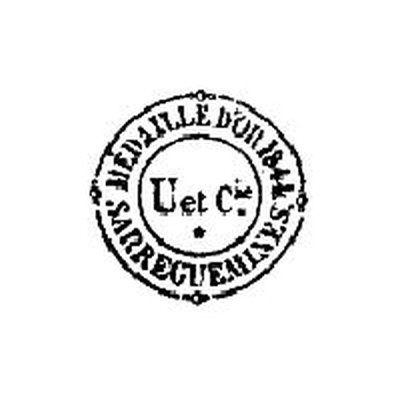
Image 020201-02-01
"Medaille d'Or 1844" or "1849 U & C Sarreguemines" in a double circle. Was used until the mid 1850's (size of the mark: 2.1 cm diameter).
Production started in 1790 when Nicolas-Henri Jacobi together with two other partners set up the first factory despite the unfavourable economic climate. Jacobi then bought an oil mill by the river and transformed it into a stone-grinding mill. In 1794, Jacobi took over the molds and left-over material from the facility in Ottweiler a.d. Saar, which had stopped producing porcelain around 1770 shortly after being taken over by René François Jolly and Nikolas Leclerc in 1769.
Still, the difficulties in obtaining supplies of raw materials as well as the hostility and suspicion of local inhabitants remained. In addition to the competition from the large amount of English and French manufacturers, the upheaval caused by the Revolution finally forced Jacobi to give up.
The dynamic Bavarian Paul Utzschneider took over the factory in 1800 and introduced new decorating techniques. Napoleon I became one of his best customers and ordered several pieces. Business quickly increased, and the firm soon had to open new workshops and acquire several mills. The protests provoked by the consequences of deforestation induced the company to use coal instead of wood, but it was not until 1830 that the first coal-fired kilns were built.
In 1836 Paul Utzschneider finally handed over the management of the factory to his son-in-law Alexandre de Geiger, who erected new buildings that were in harmony with the landscape; the Moulin de la Blies mill was built in 1841 in this spirit. In 1838 Alexandre de Geiger associated himself with Villeroy & Boch and this agreement contributed to the growth of production.
The industrial revolution was in full swing, and a new architecture emerged with the appearance of saw-tooth roofs and round chimney stacks tall enough to prevent smoke from drifting over neighbouring houses. The new factories built in 1853 and 1860 completely relied on steam-powered machinery and in the workshops, modernization centred mainly on the energy needed to operate the machines.
Note that the part of Utzschneider & Cie. specialized on (floor) tiles during 1865 became known as Utzschneider & Ed. Jaunez based on a contract between de Geiger and Eduard Jaunez (*1834 Metz, †1916). During his active lifetime, Eduard Jaunez also established or acquired factories in Wasserbillig (Luxemburg, 1873), Paray-le-Monial et Jubise (Belgium, 1876), Pont-Ste-Maxence (France, 1881), Zahna (Germany, 1890) and Betschdorf (Alsace, 1901).
Following the annexation of the Moselle to Germany, Alexandre de Geiger left Sarreguemines and retired in Paris in 1871. His son Paul de Geiger took over the management and two new factories were constructed at Digoin and Vitry-le-François. Paul de Geiger died in 1913, the year in which Utzschneider & Cie. was split into two companies, one responsible for the factory in Sarreguemines and the other for the French factories.
After the First World War the factories were united under the name of Sarreguemines - Digoin - Vitry-le-François and run by the Cazal family. During the World War II, the faience factories were sequestered and their management entrusted to Villeroy & Boch between 1942 and 1945. After stopping production of porcelain and majolica, the company was taken over in 1979 by the Lunéville - Badonviller - Saint Clément group.
In 1982 the company was renamed to Sarreguemines - Bâtiment and became the main sponsor of the Sarreguemines museum which has direct access to the company archives. The company therefore states that all inquiries regarding old items should be sent directly to the museum. Which (of course) mostly refers to museum publications that appear nicely priced at first, but make sure to get a correct handling fee quotation before you order!
The marks listed here are incomplete; there are many more to be found online. Also, some sites claim that the mark showing the Lorraine coat of arms above 'MADE IN GERMANY' was used until 1922, which is incorrect simply because the area became French territory after the first World War. The mark itself was indeed used until 1922, but without the 'MADE IN GERMANY' addition from 1918 onwards.
Thanks to the Sarreguemines Museum I saw myself forced to remove some of the previously shown marks and am not sure about the remaining dates at all. Over time, I received three different mark tables from them which all show different date entries and explanations; I assume that they do not know what they are doing and simply rewrite their own history every few years.

Image 020201-02-01
"Medaille d'Or 1844" or "1849 U & C Sarreguemines" in a double circle. Was used until the mid 1850's (size of the mark: 2.1 cm diameter).
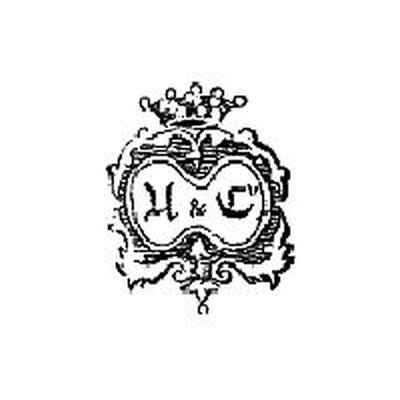
Image 020201-02-02
'U & C' in gothic letters, this type of mark was used from the end of the 1840's to the beginning of the 1860's (size about 2.1 cm high).
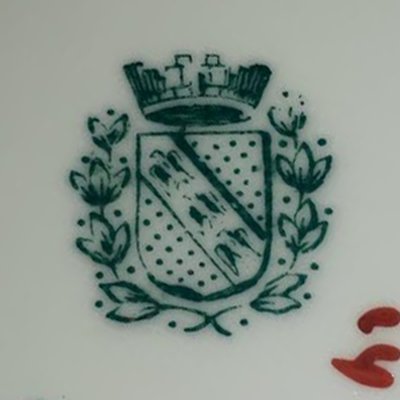
Image 020201-02-03
Used approx. from 1860 until 1922. Lorraine coat-of-arms under a mural crown, no additions.
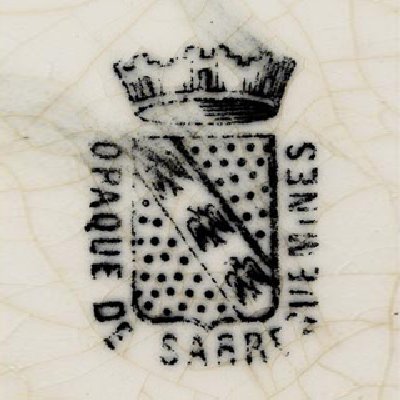
Image 020201-02-04
Used approx. from 1875 until 1900. Lorraine coat-of-arms under a mural crown, "Opaque de Sarreguemines" addition.
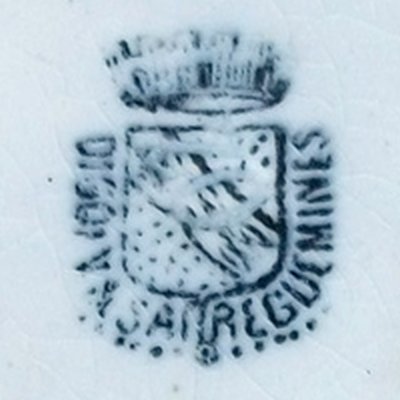
Image 020201-02-05
Used approx. from 1875 until 1900. Lorraine coat-of-arms under a mural crown, "Digoin & Sarreguemines" addition.
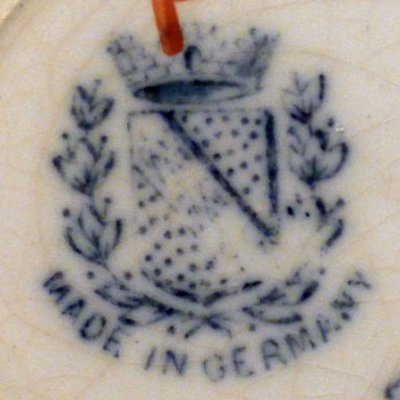
Image 020201-02-06
Used approx. from 1894 until 1919. Lorraine coat-of-arms under a mural crown, "Made in Germany" addition.
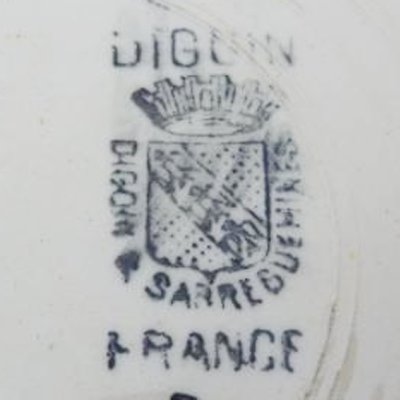
Image 020201-02-07
Used between 1875 and 1900, "Sarreguemines" in cursive script with an "U & C" overlay. Mark size varies between 3.5 and 6 cm.
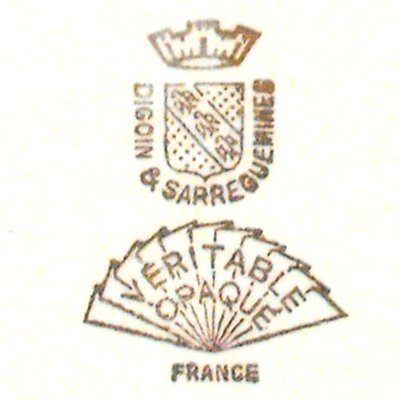
Image 020201-02-08
Used between 1890 and 1910 on certain decorative faience objects. Mark size varies between 4 and 6.5 cm.
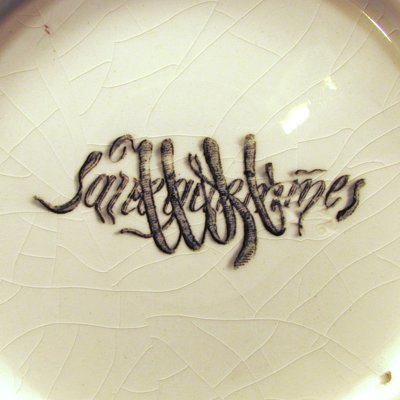
Image 020201-02-09
Used between 1890 and 1918, one of many mark versions. Other examples would (for example) include "Fleury" or "Moliére".
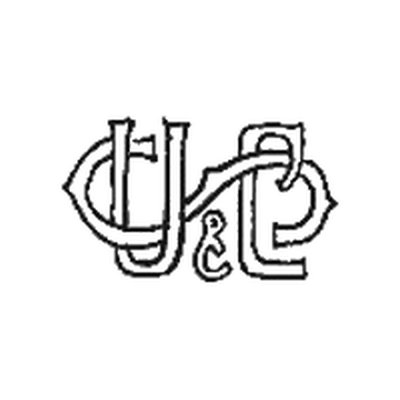
Image 020201-02-10
Used around 1900, line of country/area names (here: "Bretons"), "U&Cie" above main mark.
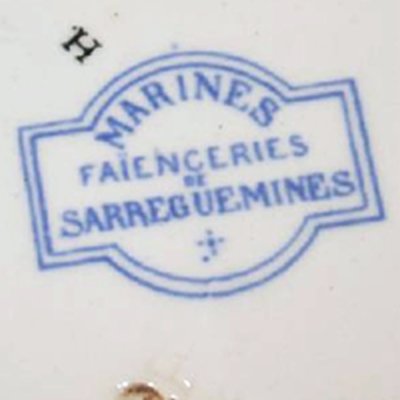
Image 020201-02-11
Used around 1900, line of country/area names (here: "Espangne"), "U&Cie" inside main mark.
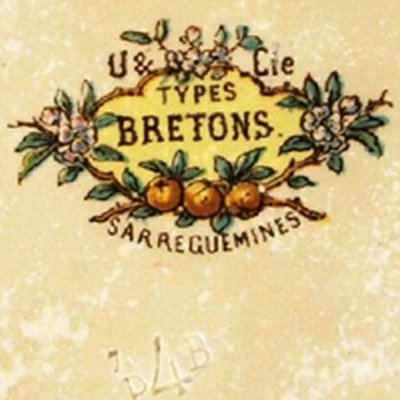
Image 020201-02-12
Used around 1900, line of country/area names (here: "Asia"), "U&Cie" inside main mark.
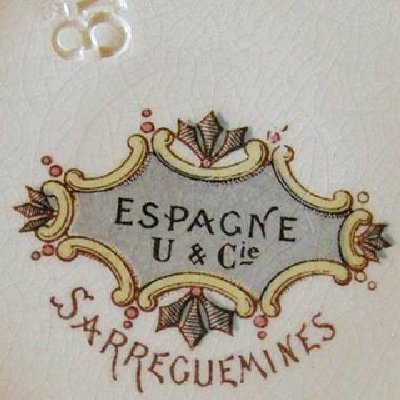
Image 020201-03-01
Mark used after 1918 on cheaper products. This one reads "Fontanges", other examples would be "Germaine" or "ITALIA".
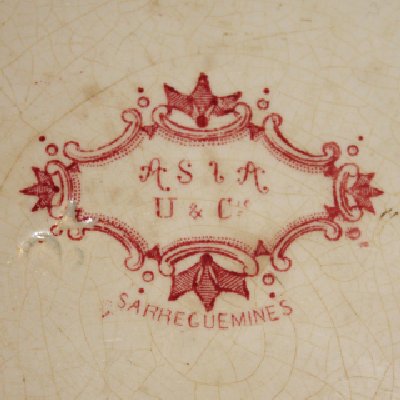
Image 020201-03-02
Used between around 1920 and 1950. Note "D.V." monogram and "Made in France".
(Picture by Trudy von Linsowe)
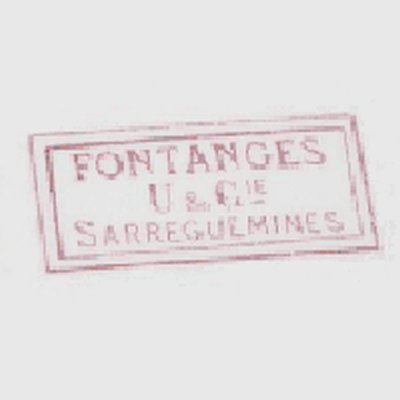
Image 020201-03-03
Used between 1920 and 1950. This mark clearly states "Digoin" above the crown.
(Picture: Rachel, Pam & Bruce)
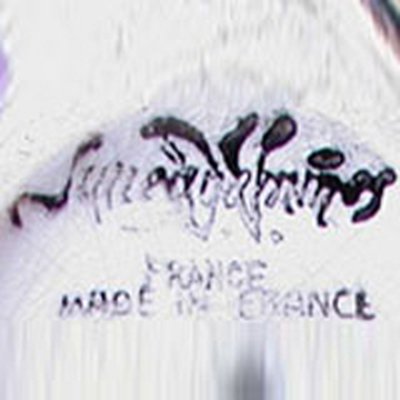
Image 020201-03-04
Used between 1920 and 1950. Another example with an additional "Veritable Opaque" mark.
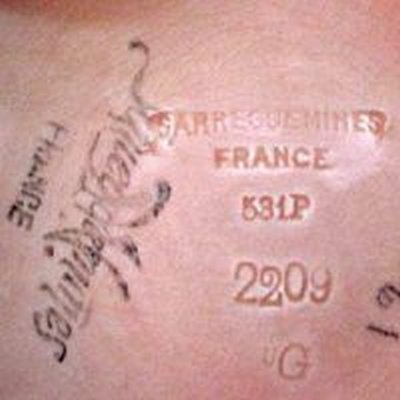
Image 020201-03-05
Used between around 1960 and 1982. Note "D.V." monogram, double marked item (stamped and impressed).
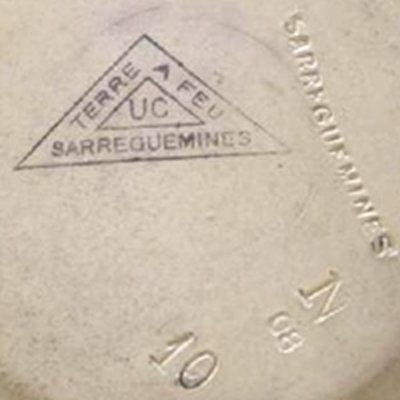
Image 020201-03-06
Used between around 1922 and 1955. Triangular mark reading "Terre a Feu" and "Sarreguemines".
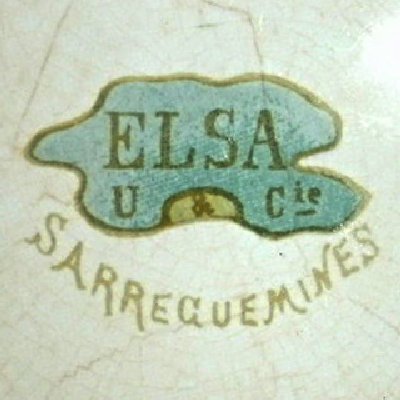
Image 020201-00-01
No date known, "Elsa" series.
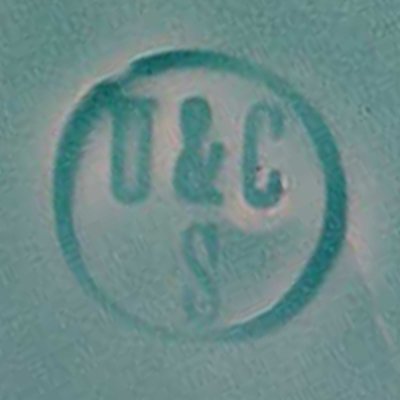
Image 020201-00-02
No date known, impressed "U & C" above "S".
© 2004-2026 C.S.Marshall, all rights reserved